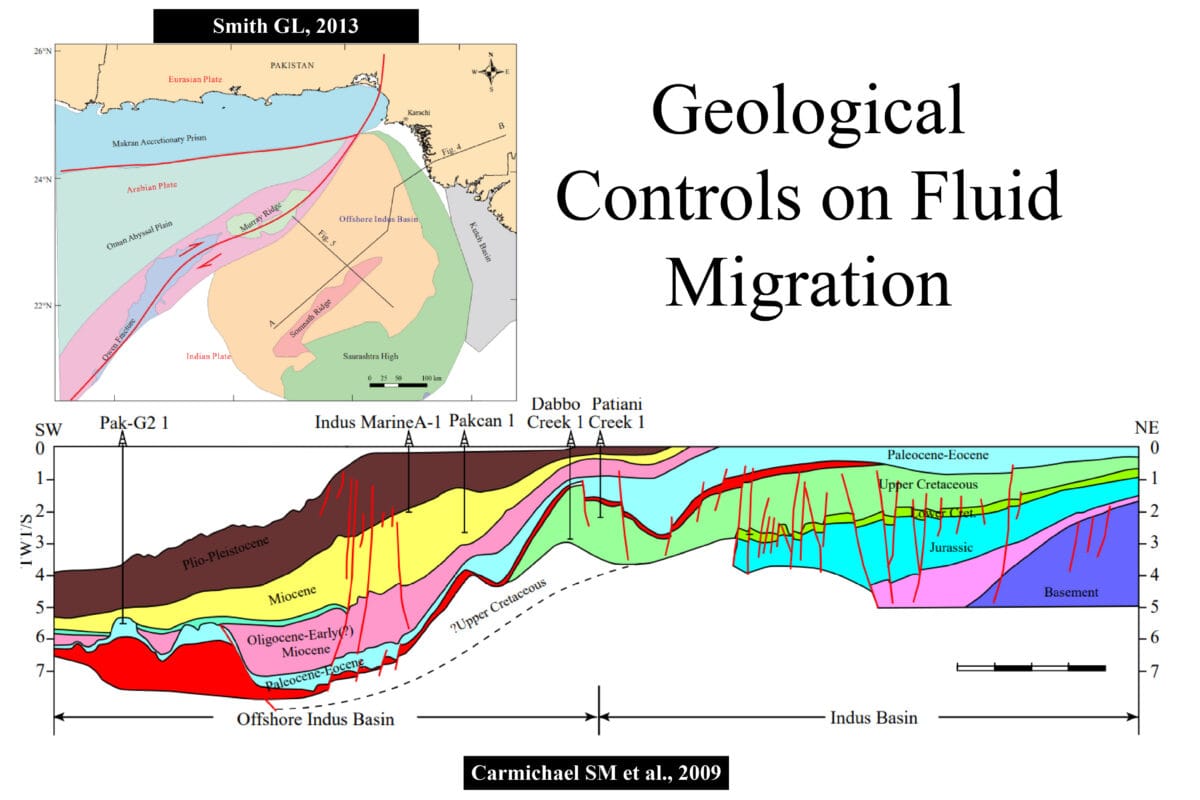Capillary Seals and Migration
Capillary seals are the primary mechanism controlling the movement of hydrocarbons within a sedimentary basin. These seals form barriers within the porous rock layers, preventing the vertical migration of oil and gas. Instead of moving upward toward the surface, hydrocarbons are often forced to migrate laterally along the stratigraphic layers of the basin.
Capillary seals arise due to differences in the rock properties, particularly pore throat sizes. Rocks with smaller pores (like mudstones or shales) generate higher capillary pressures that trap hydrocarbons beneath them. Vertical migration can only occur if the pressure from the buoyancy of oil and gas is strong enough to overcome this capillary force. As a result, lateral migration becomes the more common pathway for hydrocarbons, with the accumulation of oil and gas occurring in traps when they encounter geological structures like folds, faults, and salt domes.
Migration Rate
Hydrocarbon migration is a slow and gradual process, often taking years or even decades for hydrocarbons to move across pore spaces in a reservoir rock. The migration rate is influenced by a combination of capillary pressure, buoyancy, and the properties of the fluids involved, such as the mixture of oil and gas.
Capillary pressure refers to the resistance that hydrocarbons face when moving through small pore spaces in the rock. This resistance increases with smaller pore sizes, requiring higher buoyancy forces to drive the fluids. The rate of migration is also determined by the generation rate of hydrocarbons from the source rock. If the production of oil and gas is slow, migration will occur at a similarly slow pace, with hydrocarbons moving as they are generated.
Long-Distance Migration
In some basins, hydrocarbons can migrate over long distances, often traveling hundreds of kilometers before accumulating in traps. This long-distance migration is typical in low-relief basins, such as forland or continental basins, where geological structures do not impede lateral movement.
The ability of hydrocarbons to migrate over such distances is largely driven by the volume of hydrocarbons generated by the source rock. Rich source rocks that produce significant quantities of oil and gas push these fluids across the basin, allowing them to travel far before encountering a trap. The absence of substantial structural barriers also facilitates extended lateral migration, with hydrocarbons only accumulating when they encounter faults, pinch-outs, or other obstacles.
Capillary Pressure and Traps
Vertical vs. Lateral Migration
Vertical migration is typically more difficult due to the strong capillary pressures associated with impermeable or low-permeability rock layers. These barriers prevent hydrocarbons from moving upward unless the buoyancy forces can overcome the capillary resistance, which often requires a significant column of oil or gas. As a result, vertical migration is less common, and hydrocarbons are more likely to migrate laterally.
Lateral migration is easier because it encounters fewer barriers. Within a stratigraphic layer, such as a sandstone or carbonate, capillary pressures are often lower, making it easier for hydrocarbons to move sideways. This lateral migration continues until hydrocarbons encounter a trap that forces them to accumulate, such as a fault, a pinch-out, or a structural dome.
Capillary pressure and rock types: Different rock types exhibit varying levels of capillary pressure due to differences in pore throat sizes:
Shales or mudstones have small pore throats, creating high capillary pressures and acting as effective seals.
Sands or carbonates typically have larger pore throats, making them more permeable and allowing easier fluid movement.
This variation in capillary pressure influences the arrangement of oil and gas. Gas, being more buoyant, is often found above oil, but capillary pressure differences in the rock can cause hydrocarbons to accumulate in different ways, either vertically or laterally.
Capillary Pressure’s Role in Trap Formation
Capillary pressure is crucial in forming traps where hydrocarbons accumulate. When oil and gas migrate, they accumulate in areas where there is a significant difference in capillary pressure between rock layers. If the capillary pressure in a seal is high, hydrocarbons accumulate below it until the buoyancy pressure exceeds the capillary resistance, leading to the formation of reservoirs.
Traps such as faults, folds, and salt domes are critical for halting lateral migration and forcing hydrocarbons to accumulate. High-capacity traps with strong seals can hold large volumes of hydrocarbons, while weaker traps may only retain smaller quantities. This explains why some fields are larger and more productive than others.
What is happening in the area you’re working, please share your views!!!
Reference
Concepts and explanations regarding capillary seals, migration rates, and long-distance migration have been drawn from the presentation by Dr. Zong on “Capillary Seals and Petroleum Migration”.
Diagrams are also taken from this AAPG paper, “Migration and Charge Risk for Stratigraphic Traps “

